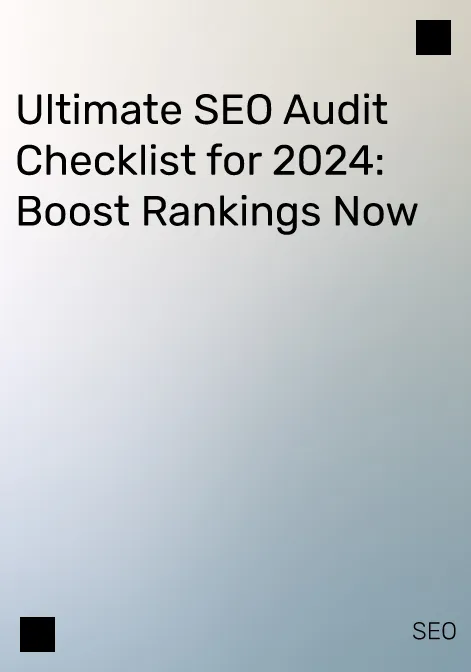Having a website is no longer sufficient in today’s digital world. Keeping your website healthy and performing well is crucial to staying competitive.
The SEO audit plays a critical role in this process. You should think of it as a routine check-up for your website to determine how well it is performing and what needs to be corrected.
A regular audit can improve your search engine rankings, improve user experience, and detect potential problems before they become serious. Here is a guide to conducting a thorough SEO audit for your website.
Technical SEO Audit
Website Crawling & Indexing
First things first, ensure that search engines can find and index all your web pages. Crawling and indexing are essential for getting your content on search engine results. Use tools like Google Search Console and Screaming Frog to check that your important pages are being crawled and indexed. Don’t forget to review your robots.txt file and sitemap to make sure they’re correctly set up.
Mobile-Friendliness
More people are browsing the web on their phones than on desktops, so your site must be mobile-friendly. Mobile-first indexing means Google primarily uses the mobile version of your site for ranking and indexing. Test your site’s mobile compatibility with Google’s Mobile-Friendly Test and Page Speed Insights. Fix any issues to ensure your site is responsive and loads quickly on all devices.
Page Speed and Performance
Nobody likes slow websites. Page speed is crucial for user experience and can affect your search rankings. To check your site’s speed, use tools like Google Page Speed Insights and GTmetrix. Look at your Core Web Vitals and improve them by optimizing images, minifying code, and using browser caching.
HTTPS Status and Security
Security is key. Ensure your website uses HTTPS for better security and trustworthiness. This not only keeps your site safe but also improves your SEO ranking. Use an SSL Checker to confirm your SSL certificate is working correctly and that your site is secure.
On-Page SEO Audit
Meta Tags Optimization
Meta tags play a significant role in how your pages appear in search results. Audit and optimize your title tags, meta descriptions, and H1 tags to align with your target keywords. A well-crafted meta tag can improve your click-through rate (CTR) significantly.
Content Quality and Keyword Usage
Content is king, but only if it’s relevant and high-quality. Evaluate your content for relevance, quality, and proper keyword usage. Avoid keyword stuffing and ensure that your content meets the search intent of your audience. Regular content audits can help maintain and improve content quality.
Internal Linking Structure
A strong internal linking structure distributes link equity and improves user flow. Review your links to ensure there are no broken ones and that your anchor text is informative and helpful. Proper internal linking helps search engines understand the context and relationship between pages on your site.
Image Optimization
Images can slow down your site if not optimized. Check for missing or poorly optimized Alt texts and compress images to reduce load time. Properly optimized images improve accessibility and enhance your SEO.
Off-Page SEO Audit
Backlink Profile
Backlinks are votes of confidence from other sites. Analyse your backlink profile using tools like Ahrefs or MOZ Link Explorer. Identify and remove toxic links that may harm your site. Focus on building high-quality backlinks to increase your domain authority.
Competitor Analysis
Learn from your competitors. Conduct a competitor analysis to evaluate their backlinks and keyword rankings. This can help you identify link opportunities and areas where you can improve.
User Experience (UX) Audit
Navigation and Usability
A user-friendly navigation structure reduces bounce rates and enhances user experience. Test your site’s usability to ensure users can easily find what they’re looking for. Good navigation improves customer satisfaction and leads to higher engagement.
Structured Data
Structured data helps search engines understand your content better and increases the chances of rich snippets appearing in search results. Implement schema markup to provide search engines with more information about your content.
Content and SEO Best Practices
Search Intent and User Engagement
Aligning your content with search intent leads to better user engagement. Focus on understanding what your audience is looking for and how you can meet those needs. Improve metrics like dwell time by creating valuable and engaging content.
Refresh Outdated Content
Keep your content fresh and competitive by regularly updating outdated content. A quick SEO content refresh can boost your rankings and bring new life to old posts. Make sure your information is current and aligns with the latest trends and user expectations.
Conclusion
Conducting a thorough SEO audit is crucial for maintaining your website’s health and performance. Maintaining your site’s competitiveness and alignment with evolving search engine algorithms can be achieved through regular audits. You need to address both technical and content-related aspects of SEO if you want your website to continue to attract and engage users.
It is important to keep in mind that SEO is a continuous process, and staying proactive will give you an advantage over your competitors. To optimize your SEO strategy further, download comprehensive guides or consult with Matic Solutions to customize solutions specifically for your business.




